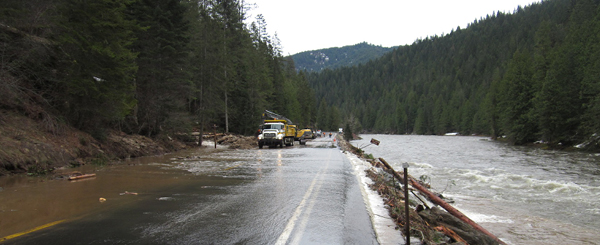Spring has sprung across the state, but the effects of one of the snowiest winters in recent memory are still being felt. Melting snow and spring rains have filled streams, creeks, and rivers across the state, increasing the likelihood of localized flooding.
“We urge drives to expect the unexpected,” said Mel Coulter, emergency program supervisor at ITD. “Local flooding is occurring statewide in areas where snow is rapidly melting and pooling on the highway.”
Water-covered roads can create hazardous conditions for drivers – it only takes about a foot of moving water on the road to cause a car to float away. Just a few inches of standing water can cause cars to hydroplane or stall. Water also can hide dangers just below the surface.
“Highways can be compromised or become unsafe because of a saturated road base. Water flowing across the highway has the potential for floating or sweeping vehicles from the road. Often those conditions are not readily visible,” said Coulter.
The first rule of driving through a flooded area is, don’t do it. The only sure way to avoid getting stranded is to find an alternate route.
If you can’t avoid a flooded area and have to drive through it, please take the following precautions:
- When approaching a depth of standing water on a road, always slow down before entering it. Even a very shallow depth of water can cause hydroplaning if entered at speed. The tires effectively lose contact with the road, resulting in a loss of steering control.
- If there are other vehicles around, watch what happens to them as they drive through the water. Doing so will help you judge its depth and how it affects the vehicle as well as warn of any hidden hazards beneath the surface.
- Proceed into the water very slowly and maintain a steady pace so as not to lose momentum. If you go too quickly, you risk losing steering control. If you go too slowly, you run the risk of getting stuck.
- Do not drive into water where power lines have fallen, as electric current can be conducted by water.
- Be particularly cautious entering a flooded area at night as it is much more difficult to identify potential hazards.
- Be considerate of others. Driving through water at speeds above a slow crawl can create a splash that inhibits the visibility of other drivers and soaks pedestrians or people trying to direct traffic.
- Watch for debris or other items that may float into your path.
- Once you are through the flooded area, be aware that your brakes will be wet and will not function normally until they dry. Light brake applications will help them dry out and return to normal more quickly.
If you become stranded, please consider the following:
- If your engine stalls and doesn’t quickly restart, do not continue to try as doing so may cause more serious damage.
- It is important to keep the situation from getting worse, so turn on your hazard warning lights to make sure other drivers can see you.
- Use your cell phone to call for help.
- If you can safely make it to higher ground on foot, leave the vehicle and do so. Be cautious of other traffic around you. Use caution when walking – moving water can make your footing unstable and maintaining your balance is more difficult.
- If it seems unsafe to leave the vehicle, stay with it. If the water level becomes too high inside, you may want to climb onto the roof to await assistance.
- Whatever the circumstance, keep calm and think through the best course of action and its consequences.
- The best advice of all, however, is simple. Do not drive in flooded road conditions if at all possible.

